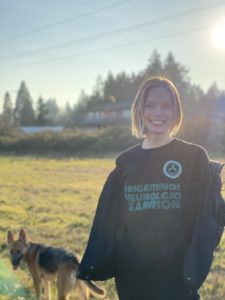When you think about a visit to the dentist, it may – at first – seem innocuous, something that you need to take care of for your health. But for some people, dental work or surgery is the first trigger for developing trigeminal neuralgia (TN), a neurological condition which causes intense and chronic pain in the trigeminal (5th) cranial nerve. For Jessica Dobbs, this is where her journey began in 2017. After visiting the dentist, she developed both types of trigeminal neuralgia – TN1 and TN2 – and has been living with it ever since.

While this type of chronic pain would cause some to retreat, Jessica has used it to spur her advocacy within the rare disease and chronic illness spheres. During the pandemic, she launched Getting On My Nerves, an online community for those with trigeminal neuralgia. She also began a free 5k to help raise funds to spur change within this community.
Recently, Jessica and I sat down to discuss what trigeminal neuralgia is, why research and understanding are so important, and how she hopes to develop Getting On My Nerves in the future.
About Trigeminal Neuralgia (TN)
As Jessica explains it:
“Trigeminal neuralgia is a rare facial pain condition which affects the trigeminal nerve, which carries sensation from the face to the brain. It’s described by the medical field as one of the worst pains known to mankind, with only complex regional pain syndrome (CRPS) higher on the McGill Pain Scale. Symptoms include electric shock-like sensations, burning, aching, searing, hammering, or excruciating pain in the cheek, teeth, jaw, and forehead.”
There are two forms of trigeminal neuralgia: TN1 and TN2. TN1 is considered to be the “typical” form of TN, which causes burning facial pain which may continue on and off for hours at a time. Jessica describes these as:
“Lightning-bolt type pains that typically come in shorter periods, lasting 30 seconds to 5 minutes, although some trigeminal neuralgia warriors experience them for much longer.”
Alternatively, TN2 is considered “atypical,” and causes a constant burning or stabbing pain. Some patients, like Jessica, may experience both TN1 and TN2. Others may have TN1 progress to become TN2. Jessica explains that, since she has both TN1 and TN2:
“I have not had a pain-free day since August 2021. I experience TN2 every day and TN1 attacks happen almost daily for me. My triggers vary based on the weather, stress, how much I’ve slept, and other factors.”
So what causes trigeminal neuralgia? Jessica says:
“There is still a lot of research being done into trigeminal neuralgia and its causes. Some theories on it include trauma and herpes zoster. But things like multiple sclerosis, blood vessels pressing on nerves, tumors, or arterial tangles have all been linked to TN.”
Who Gets Trigeminal Neuralgia?
Research shows that females typically develop trigeminal neuralgia at a higher rate than males. Additionally, those over 50 years old are believed to be at a higher risk. However, Jessica reminds us that it is important to not get so caught up in these ideas or beliefs that we reject patient experiences. For example, she shares:
“I was diagnosed at age 27, and I’m 32 now. I met a woman named Miranda who was diagnosed at three years old and has lived with trigeminal neuralgia for her entire life. She just announced her third pregnancy; she’s living, thriving, has a college degree, bought a home, got married – all of those things that don’t initially seem possible after a diagnosis. But I want to address the myths of trigeminal neuralgia and let people know that this condition affects those of all ages and backgrounds.”
Other myths that Jessica hopes to address are that children cannot get trigeminal neuralgia (they can), removing teeth helps with the pain, and microvascular decompression surgery (MVD) is a cure. MVD is a brain surgery in which doctors can see whether they can fix compression on a nerve, possibly by relieving the compression. Jessica shares that many patients experience lasting relief, but a good portion of individuals also have recurrent pain.
If you’d like to learn more about the myths surrounding TN, take a look at some of the stories and videos on Jessica’s Instagram page.
Trigeminal Neuralgia Symptoms
As explained above, chronic pain or painful spasms are a huge symptom of trigeminal neuralgia. Additional symptoms or characteristics can include:
- Dull facial pain
- Excessive salivation
- Facial or head contortion
- Pain triggered by brushing teeth, hot or cold beverages, or shaving
- Depression and/or anxiety
- Brain fog
Jessica’s Story
Growing up, Jessica Dobbs was no stranger to pain. At age five, she was diagnosed with herpes zoster, a form of localized shingles that sometimes appeared on her face; Jessica has been managing this condition throughout her upbringing. Then, at age 18, Jessica was also diagnosed with endometriosis, a painful condition in which tissue that normally lines the uterus begins to grow outside of the uterus. But, shares Jessica:
“Trigeminal neuralgia really put me face-to-face with a new kind of pain. I was diagnosed in 2017, and my whole life was turned upside down.”

Since receiving her diagnosis, Jessica has been placed on five different anticonvulsants. Unfortunately, these medications offered brutal side effects – but no particular relief. To gain relief, shares Jessica, she has to use a combination of opioid pain relievers, muscle relaxants, and medical marijuana:
“And that just takes the edge off of the pain.”
So far, Jessica has found that many people are unaware of exactly what trigeminal neuralgia is. She often finds herself having to explain it – both to other individuals and to those in the medical profession. At first, she shares, this was a huge learning curve to both grasp her condition and understand it enough to explain it. But now, she is proud that she has come such a long way and is now able to use her knowledge to educate people through activism and advocacy.
Her strongest step in this direction? The development of the Getting On My Nerves 5K.
Join us in Part 2 of our interview, where we discuss the process of developing a 5K event, how Jessica has been preparing for future events, and advice she has for those within the trigeminal neuralgia community.


